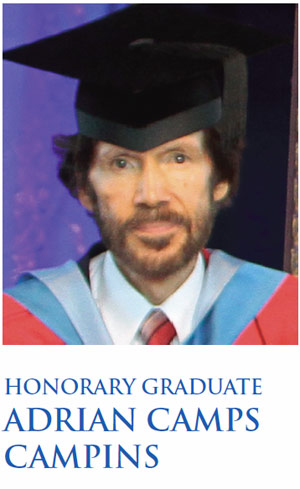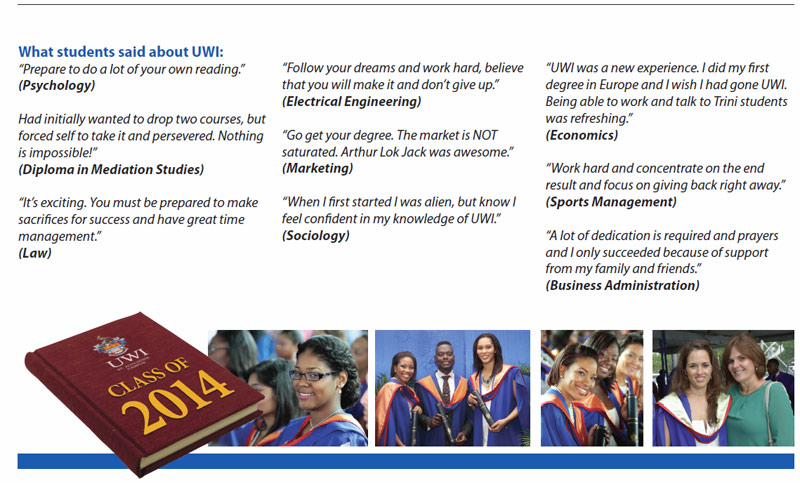 |
 |
 |
|
December 2014 |
Citation: Adrian Camps-Campins, Degree of Doctor of Letters (DLitt)Chancellor, the greatest American architect of all time, Frank Lloyd Wright once said that, “The mother art is architecture. Without an architecture of our own we have no soul of our own civilization.” Adrian Camps-Campins seems to have intuitively adopted this philosophy and bids us to join him. Born in 1943, he attended St Mary’s College in Port of Spain. He joined the insurance industry thereafter and rose to a senior position by the 1970s. All the while, however, even as a young boy, he was exposed to the artistic pursuits of his father, who, while being a physician, was also a keen watercolourist. Artistic inspiration would also come from the well-known artist, Harry Bryden who had married into the family. Adrian would leave his secure position in the insurance business in 1974 to pursue this passion for art. His accounts of those early years are filled with the texture and rich details of virtually everywhere he walked. In the mid-sixties, he experimented with portraiture in oils done from photographs, and soon began receiving commissions. The land was always speaking to him, however, so whether it was recalling Manzanilla Beach, the Maracas St. Joseph River, or scenes from a cocoa plantation, his accounts demonstrate that his gaze would routinely transcend the casual. On a visit to the western tip of Gasparee Island, that keen perception in the company, no doubt, of a romantic imagination, transported him back to the 15th century and provided a haunting image of Christopher Columbus leaving the Gulf of Paria. That vision would become his first printed card and would subsequently be captured on a postage stamp of Trinidad and Tobago in 1976. Those who would touch greatness, though, inevitably hear and answer some higher calling. Adrian Camps-Campins would seamlessly blend his love of meticulously researched history with his love of art and architecture and the world would notice. His portrayal of the late 19th century event, “Seventh Birthday Party of Clara Rosa de Lima” would be used by UNICEF in 1993 as part of their international fund-raising for children’s causes. He would also showcase his competence as a researcher in his collaboration with Professor Bridget Brereton on the autobiography of Captain Percy Fraser entitled, “Looking Over My Shoulder: Forty-Seven Years as a Public Servant.” In 2012 in commemoration of the 50th Anniversary of the Independence of Trinidad and Tobago, he presented the Government of Spain with an 8ft by 4ft painting titled, “The Last Meeting of the Spanish Cabildo, 1797.” His notable depictions include many buildings and sites of historical significance as well as aspects of our culture: early 20th century vendors, a Hindu temple, the famous Lion House, ancestral home of the Naipaul brothers and “The Carnival at Pembroke Street 1910” which offers a glimpse of the early street festival. In his own words describing the built landscape of our towns and villages, he draws our attention to the love that designed and crafted, “the gingerbread fretwork, the steep roofs, the turrets and dormers, the crestings and finials, the broad eaves, the occasional vision of joyous eccentricity.” Mr. Camps-Campins has lectured on his work in Trinidad and at Oxford University and he practises beautiful activism. Much of his work can be seen on greeting cards and this has enabled him to reach a much broader base to raise public awareness of the history of Trinidad and Tobago and its unique architecture. The famous Romanian sculptor, Constantin Brancusi, once said that, “Architecture is inhabited sculpture.” Through his work, Mr Camps-Campins has invited us to inhabit the sculptures that surround us. He has compelled us to look through his eyes and experience the wonder, beauty and reverence owed to our heritage. Chancellor, I present Adrian Camps-Campins, and ask that by the authority vested in you by the Senate and Council of The University of The West Indies, you confer on him the degree of Doctor of Letters, honoris causa.
|



